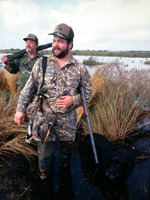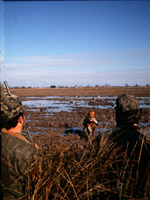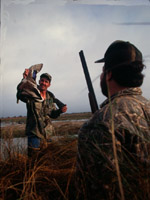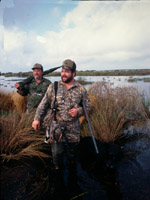
|
Features
|
|
|
|
Books
|
|
|
|
Fun & Games
|
|
|
|
Contact Us
|
|
|
John's Journal... Entry 117, Day 5
DUCKS WHEN THE WEATHER SIZZLES
Great Lakes Ducks
 EDITOR'S
NOTE: Like most duck hunters throughout the nation in the warm weather
of this past few seasons, I didn't hear the whistling wings of waterfowl
gliding out over the marsh, the constant quacking of mallards as they
fed in acorn flats or the whistling of wood ducks as they came in to roost
at night. Instead, the ever-present hum of mosquitos' wings -- millions
of them -- overpowered all the other sounds. However, while this past
year brought unseasonably-hot weather and many areas didn't see as many
ducks as they'd seen in other years, the sportsmen who knew how, where
and when to hunt quacks still found numbers of webfoots and took limits
of ducks, even though they may have killed over their limits of mosquitos.
EDITOR'S
NOTE: Like most duck hunters throughout the nation in the warm weather
of this past few seasons, I didn't hear the whistling wings of waterfowl
gliding out over the marsh, the constant quacking of mallards as they
fed in acorn flats or the whistling of wood ducks as they came in to roost
at night. Instead, the ever-present hum of mosquitos' wings -- millions
of them -- overpowered all the other sounds. However, while this past
year brought unseasonably-hot weather and many areas didn't see as many
ducks as they'd seen in other years, the sportsmen who knew how, where
and when to hunt quacks still found numbers of webfoots and took limits
of ducks, even though they may have killed over their limits of mosquitos.
Visions of the Great Lakes region, especially during the wintertime, will make you think about snow, cold weather and outstanding duck hunting. But warm weather sometimes hits the Great Lakes area of the country on the Mississippi Flyway. "Sometimes during duck season the temperature may be an unbelievable 67 degrees in our area," Fred Zink of Clayton, Ohio, a longtime guide, said. "Then four days later the wind chill may be below zero degrees. The ducks may fly down the flyway so quickly in warmer winter weather that many areas that normally hold ducks don't. I hunt the St. Marys/Grand Lake/Indian Lake/Sandusky Bay area on Lake Erie. One of my most-productive sites is Sandusky Bay on Lake Erie where we find some of the best natural-marsh hunting in the U.S. These marshes always home ducks. They're also the staging grounds for black ducks. Regardless of the weather, the ducks generally show up here."
 Zink
primarily hunts the mallard and black ducks in this region. "One
of the advantages I have is the Winos Point Hunting Club, one of the oldest
hunting clubs in the nation, that has 6500 acres of marshlands, is near
where I hunt," Zink emphasized. "I'm also close to Ottawa Point,
another hunting club with vast amounts of natural and reconstructed marshes.
These regions have buckwheat and millet planted, and the land is flooded
prior to duck season to attract ducks."
Zink
primarily hunts the mallard and black ducks in this region. "One
of the advantages I have is the Winos Point Hunting Club, one of the oldest
hunting clubs in the nation, that has 6500 acres of marshlands, is near
where I hunt," Zink emphasized. "I'm also close to Ottawa Point,
another hunting club with vast amounts of natural and reconstructed marshes.
These regions have buckwheat and millet planted, and the land is flooded
prior to duck season to attract ducks."
By hunting in Sandusky Bay near these clubs, Zink generally finds productive
duck hunting all season. Zink has learned that during warm weather the
natural marshes usually produces better duck hunting than flooded corn
fields or other grain-oriented areas do. "When ducks or geese eat
grain, especially corn, that grain creates heat in their craws,"
Zink explained. "They'd rather eat invertebrates, insects and natural
foods when the weather is warm and not have that build-up of heat in their
craws." Zink hunts the ducks going to and coming away from the natural
marshes. "If I'm setting up along the edges of bays and sloughs in
the ducks' natural flyways, I'll only use six or eight decoys," Zink
commented. "I'll sit the decoys out on the water where I've seen
ducks feeding before. I'll call very little. I just want to sound like
resting ducks feeding on the water. Remember, when you hunt next to where
the ducks want to be, you don't have to blow them out of the sky with
loud, aggressive calling."
 Because
of the duck-hunting pressure in the Great Lakes region, often these sloughs
and bays will have numbers of other hunters in them. But if Zink finds
all the best duck-hunting hotspots taken, he doesn't roll up his decoys
and go home. Instead he hunts the open water. "When you hunt open
water, you must have 100 to 200 decoys," Zink advised. "You
need to plan to hunt at the crack of dawn and then again from 10:00 a.m.
until 12:00 noon. These two flight periods seem to be when the most ducks
move." To shoot the ducks on open water, Zink uses a one-man, flat-bottomed,
shallow-draft, 8-foot long and 4-foot wide, layout boat with sides only
5 1/2-inches above the water. When the ducks come in, the hunter simply
sits up and begins to shoot.
Because
of the duck-hunting pressure in the Great Lakes region, often these sloughs
and bays will have numbers of other hunters in them. But if Zink finds
all the best duck-hunting hotspots taken, he doesn't roll up his decoys
and go home. Instead he hunts the open water. "When you hunt open
water, you must have 100 to 200 decoys," Zink advised. "You
need to plan to hunt at the crack of dawn and then again from 10:00 a.m.
until 12:00 noon. These two flight periods seem to be when the most ducks
move." To shoot the ducks on open water, Zink uses a one-man, flat-bottomed,
shallow-draft, 8-foot long and 4-foot wide, layout boat with sides only
5 1/2-inches above the water. When the ducks come in, the hunter simply
sits up and begins to shoot.
"We position the layout boats to have the wind at the hunters' backs," Zink said. "We use either a U-shaped or a pocket-type decoy set with plenty of decoys in front of, beside and behind the boat and leave a small pocket of open water in front of the boat in which the ducks can light. When the water has a foot to a 1 1/2-foot chop, the ducks really can't see the layout boat, which I think looks like an upside-down frisbee. Of course the hunters will get wet, but duck hunting isn't a dry sport. When hunting open water in a layout boat, you must call much more aggressively and louder than you do when hunting the marshes and sloughs."
 The
layout boat seems to work best when you hunt ducks that have frequented
an area for awhile in the Great Lakes region and have experienced plenty
of hunting pressure. However, when cold weather arrives and new ducks
fly into an area, you can hunt the ducks on open water from a conventional
boat blind, because the new ducks may consider the boat blind an island
when they first see it.
The
layout boat seems to work best when you hunt ducks that have frequented
an area for awhile in the Great Lakes region and have experienced plenty
of hunting pressure. However, when cold weather arrives and new ducks
fly into an area, you can hunt the ducks on open water from a conventional
boat blind, because the new ducks may consider the boat blind an island
when they first see it.
Check back each day this week for more about Ducks...
Day 1 - Hunting Warm-Weather
Ducks
Day 2 - Saltwater-Marsh Ducks
Day 3 - Freshwater-Marsh Hunting
Day 4 - Field Hunting
Day 5 - Great Lakes Ducks